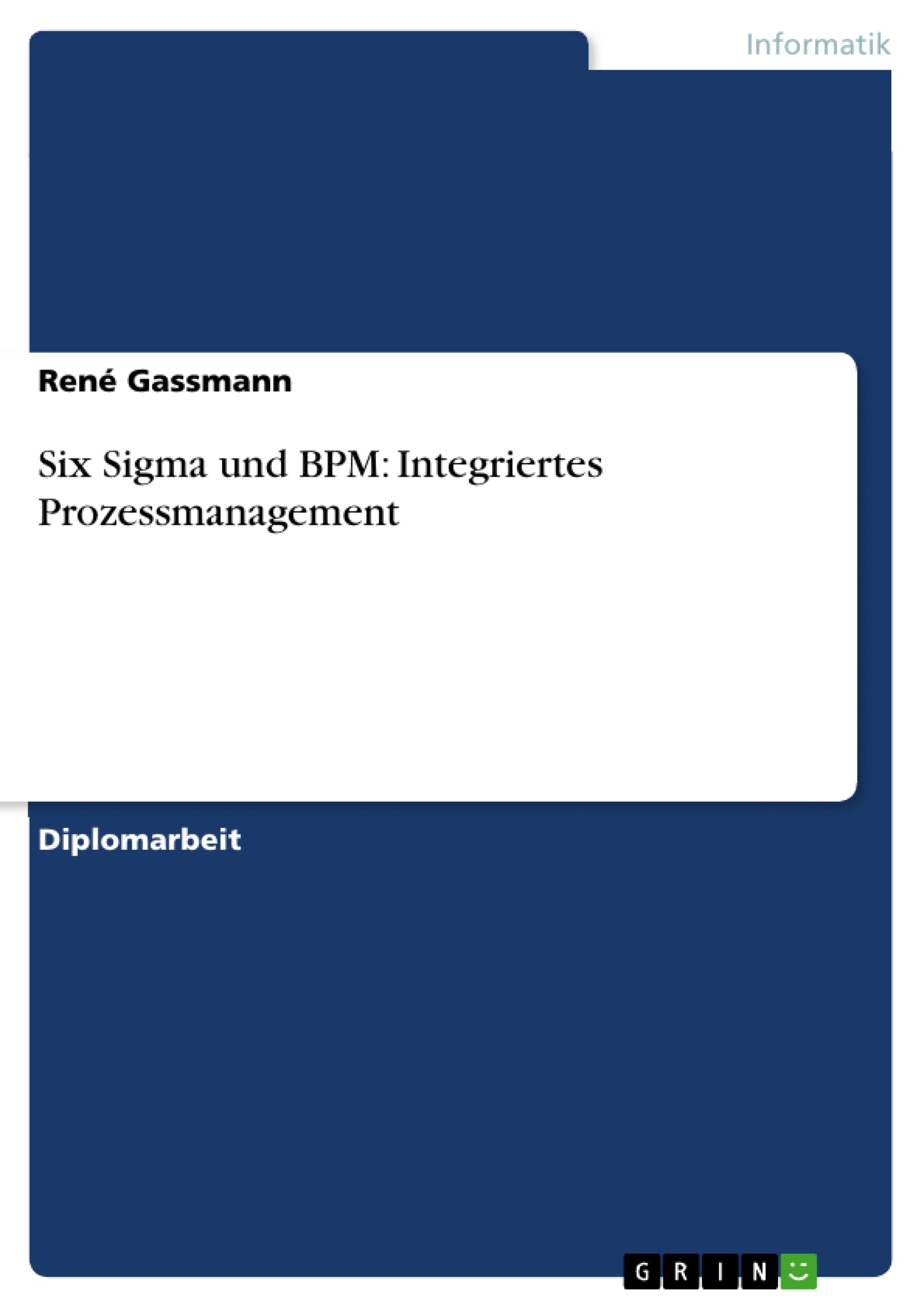Unternehmen des 21. Jahrhunderts stehen vor der Herausforderung, in Zeiten stetigen Wandels erfolgreich zu sein. Zur Bewältigung dieser Aufgabe sind zahlreiche Managementkonzepte entwickelt worden, darunter etliche, die eine prozessorientierte Unternehmensgestaltung zum Inhalt haben (vgl. SCHMELZER/SESSELMANN 2008).
Ein populärer Ansatz der Prozessoptimierung ist die Six Sigma-Methode, die mit einem analytisch geprägten Vorgehensmodell das Ziel verfolgt, nahezu fehlerfreie Produkte und Dienstleistungen zu erstellen. Die Methode nimmt für sich in Anspruch, zur Steigerung der Wettbewerbsfähigkeit von Unternehmen beitragen zu können (vgl. z. B. MOORMANN et al. 2009, S. 4 f.). Ob Six Sigma diesem Anspruch gerecht wird, darf inzwischen angezweifelt werden. So stellt HAMMER (2002, S. 30) fest: „Although Six Sigma can lead to higher quality and lower costs, it is not effective at generating dramatic improvements in business performance.” Basierend auf einer Studie der Six Sigma-Aktivitäten bei Bombardier (vgl. HAMMER 2002, S. 30 f.) werden dafür u. a. folgende Gründe angeführt:
- Six Sigma fokussiert auf Teilprozesse, deren Optimierung isoliert betrachtet lohnend ist, aus Sicht der Gesamtprozesse jedoch zu Suboptima führen kann.
- Die Effektivität des betrachteten Prozesses als solches wird grundsätzlich nicht in Frage gestellt; alle Bestrebungen beschränken sich auf eine Steigerung der Effizienz.
- Six Sigma trägt nicht nennenswert dazu bei, ein funktional organisiertes Unternehmen in ein prozessorientiertes zu überführen. Implikationen auf Unternehmenskultur und Organisationsstruktur werden ausgeblendet.
Als Lösung gilt die Integration von Six Sigma und Business Process Management (BPM). Beispielsweise HAMMER (2002, S. 32) rät: „To overcome six sigma’s limitations and get the most of it, companies should position it in the larger context of process management“ (vgl. LEYENDECKER 2009; SCHMELZER/SESSELMANN 2008, S. 396; TÖPFER/GÜNTHER 2007, S. 31). Wie eine solche Kombination idealerweise auszugestalten ist, wird nicht beschrieben. Es finden sich lediglich rudimentäre Ansätze (vgl. z. B. GIBBS/SHEA 2007; REDINIUS 2004; REHBEHN/YURDAKUL 2005), die eine organisations-theoretische Fundierung vermissen lassen und die Rolle der Informationstechnologie nur unzureichend würdigen.
Inhaltsverzeichnis
- Abkürzungsverzeichnis
- Abbildungsverzeichnis
- 1 Einleitung
- 1.1 Problemstellung
- 1.2 Zielsetzung
- 1.3 Aufbau der Arbeit
- 2 Prozessorganisation aus Sicht der Organisationstheorie
- 2.1 Terminologische Grundlagen
- 2.1.1 Prozessorganisation
- 2.1.2 Organisationsbegriff
- 2.1.3 Organisationstheorien
- 2.2 Generische Probleme der Organisationsgestaltung
- 2.2.1 Strukturierung von Aufgaben
- 2.2.2 Integration von Individuum und Organisation
- 2.2.3 Organisation und Umwelt
- 2.2.4 Emergente Phänomene in Organisationen
- 2.2.5 Organisatorischer Wandel und Transformation
- 2.3 Bezüge zur Unternehmensstrategie
- 2.3.1 Market Based View (MBV)
- 2.3.2 Resource Based View (RBV)
- 2.3.3 Hybrider Strategieansatz
- 2.3.4 Prozessorganisation im Kontext der Unternehmensstrategie
- 2.4 Systematische Ansätze und Erweiterungen der Prozessorganisation
- 2.4.1 Business Process Reengineering (BPR)
- 2.4.2 KAIZEN/Kontinuierlicher Verbesserungsprozess (KVP)
- 2.4.3 Total Cycle Time (TCT)
- 2.4.4 Lean Management
- 2.4.5 Business Process Management (BPM)
- 2.4.6 Six Sigma
- 2.5 Integrationskontext
- 2.1 Terminologische Grundlagen
- 3 Prozessorganisation aus Sicht der Informationstechnologie
- 3.1 Terminologische Grundlagen
- 3.1.1 Informationssysteme
- 3.1.2 Informationstechnologie
- 3.1.3 Methoden
- 3.1.4 Modelle
- 3.2 Der informationstechnologische Beitrag zur Prozessorganisation
- 3.2.1 IT als Enabler
- 3.2.2 IT als Facilitator
- 3.2.3 IT als Implementor
- 3.3 Funktionsspektrum von Prozessmanagement-Tools
- 3.3.1 Visualisierung
- 3.3.2 Modellierung
- 3.3.3 Simulation
- 3.3.4 Automatisierung
- 3.4 Erweiterter Integrationkontext
- 3.1 Terminologische Grundlagen
- 4 Business Process Management
- 4.1 Terminologische Grundlagen
- 4.1.1 Prozessbegriff
- 4.1.2 Prozessklassen, Prozessstrukturen und Prozesstypen
- 4.1.3 Modelle im Prozessmanagement
- 4.1.4 Leistungsparameter
- 4.1.5 Rollen
- 4.2 Management von Geschäftsprozessen
- 4.2.1 Grundlagen
- 4.2.2 Systematische Ansätze des Geschäftsprozessmanagements
- 4.3 Generischer Ansatz des Geschäftsprozessmanagements
- 4.3.1 Strategisches Prozessmanagement
- 4.3.2 Prozessgestaltung
- 4.3.3 Prozessrealisierung
- 4.3.4 Prozesscontrolling
- 4.4 BPM als Integrationsgegenstand
- 4.1 Terminologische Grundlagen
- 5 Six Sigma
- 5.1 Einführung
- 5.2 Der konzeptionelle Rahmen
- 5.2.1 Verpflichtung der Unternehmensleitung
- 5.2.2 Einbeziehung der Stakeholder
- 5.2.3 Ausbildungsprogramm
- 5.2.4 Messsystem
- 5.2.5 Verbesserungsprojekte
- 5.2.6 Unternehmenskultur
- 5.3 Umsetzungsarten
- 5.3.1 Toolbox
- 5.3.2 Verbesserungsprogramm
- 5.3.3 Unternehmensweite Strategie
- 5.4 Vorgehensmodelle
- 5.4.1 Der reaktive Ansatz: Prozessoptimierung mit dem DMAIC-Zyklus
- 5.4.2 Der proaktive Ansatz: Design for Six Sigma
- 5.4.3 Der integrierte Ansatz: Lean Six Sigma
- 5.5 Six Sigma als Integrationsgegenstand
- 6 Integration von Six Sigma und BPM
- 6.1 Literaturbefunde
- 6.2 Integrationsbegriff
- 6.3 Integrationskonzept
- 6.3.1 Unternehmensstrategie
- 6.3.2 Organisationsgestaltung
- 6.3.3 Unternehmenskultur
- 6.3.4 Informationstechnologie
- 6.3.5 Methode
- 7 Resümee und Ausblick
- 7.1 Kritische Schlussbetrachtung
- 7.2 Anknüpfungspunkte für zukünftige Forschungsvorhaben
- Literaturverzeichnis
Zielsetzung und Themenschwerpunkte
Die vorliegende Arbeit befasst sich mit der Integration von Six Sigma und Business Process Management (BPM). Ziel ist es, einen theoretisch fundierten Ansatz für die Kombination dieser beiden Konzepte zu entwickeln, um die Stärken beider Ansätze zu vereinen und die Schwächen zu minimieren.
- Theoretische Grundlagen der Integration von Six Sigma und BPM
- Beitrag der Informationstechnologie (IT) zur Integration
- Entwicklung eines Integrationskonzepts für Six Sigma und BPM
- Bewertung des Integrationsansatzes aus unternehmensstrategischer Sicht
- Analyse der Auswirkungen der Integration auf Organisationsstruktur und Unternehmenskultur
Zusammenfassung der Kapitel
Die Arbeit beginnt mit einer Einführung in die Problemstellung, die Zielsetzung und den Aufbau der Arbeit. Kapitel 2 behandelt die prozessorientierte Organisationstheorie, beleuchtet die generischen Probleme der Organisationsgestaltung und stellt den Zusammenhang mit der Unternehmensstrategie her. Kapitel 3 beschäftigt sich mit der Rolle der Informationstechnologie (IT) in der Prozessorganisation. In Kapitel 4 wird Business Process Management (BPM) als Managementkonzept für die Steuerung von Geschäftsprozessen vorgestellt. Kapitel 5 beschreibt Six Sigma als Methode zur Verbesserung von Prozessen und Produkten. Kapitel 6 präsentiert ein Integrationskonzept für Six Sigma und BPM, das die vier Dimensionen Unternehmensstrategie, Organisationsstruktur, Unternehmenskultur und Informationstechnologie berücksichtigt. Abschließend erfolgt in Kapitel 7 eine kritische Schlussbetrachtung und ein Ausblick auf weitere Forschungsvorhaben.
Schlüsselwörter
Prozessorganisation, Six Sigma, Business Process Management (BPM), Integration, Informationstechnologie, Unternehmensstrategie, Organisationsstruktur, Unternehmenskultur, DMAIC-Zyklus, Lean Six Sigma, Prozessmodellierung, Prozessanalyse, Prozessoptimierung, Workflow-Management-Systeme.
- Quote paper
- René Gassmann (Author), 2010, Six Sigma und BPM: Integriertes Prozessmanagement, Munich, GRIN Verlag, https://www.grin.com/document/193448




